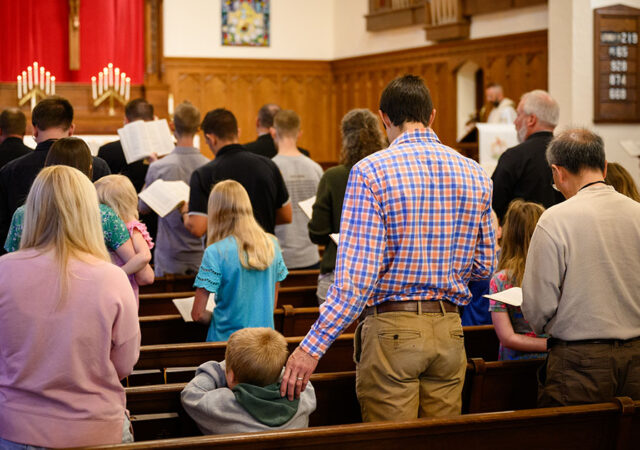By Paula Schlueter Ross
In a bold move designed to make the cost of a private education more affordable, Concordia University in St. Paul, Minn., is decreasing the annual tuition for its traditional undergraduate program by $10,000.
The tuition decrease — which takes effect next fall with the 2013-14 academic year — will be available to new and current students. It represents a 33 percent cut from the 2012-13 tuition price of $29,700, bringing annual tuition to $19,700. The price of room and board will remain at its 2012-13 level for 2013-14.
“In resetting our tuition to a price last seen a decade ago, we are responding to the concerns of students and families who feel our nation’s colleges have become unaffordable,” said Concordia President Rev. Tom Ries. “We hope that other private colleges and universities will soon be able to follow our lead.”
Nothing will be cut or eliminated from the Concordia educational experience, in or out of the classroom, to accommodate the tuition reset, administrators say.
“After many years of prudent living within our means, we now have the fiscal capability to reduce our tuition price without sacrificing the quality education Concordia is known for providing,” said Ries. “We had record enrollment numbers and a higher academic profile for our entering class in 2012-13, so Concordia itself is currently in a position of strength.
“But the economic recession has eroded the financial situations of the students and families we serve, so we recognized the call to respond in keeping with our mission to provide an education of outstanding value at an affordable cost.”
The decrease in tuition is accompanied by a decrease in the amount of financial aid that Concordia awards. But the school’s move from a high-tuition/high-discount model to a low-tuition/low-discount model is expected to lower the out-of-pocket costs for all students, regardless of need.
And, because need-based aid will stretch farther and out-of-pocket costs will drop, the tuition reset is expected to decrease families’ reliance on unsubsidized parent loans and private student loans.
“We are allowing federal and state grants to stretch farther for students who qualify for the maximum in need-based aid,” explains Eric LaMott, senior vice-president and chief operating officer at Concordia. “And the tuition reset also makes Concordia a more viable option for students who don’t qualify for need-based aid and are often forced to overlook private Christian higher education simply because of the high ‘sticker price.’ “
Concordia’s lower tuition “better reflects the actual cost before need-based aid,” according to the school.
Kristin Vogel, director of undergraduate admissions at Concordia, puts it this way: “We are bringing a dose of reality to the marketplace by being transparent about our pricing, since the published price at most private colleges and universities, including Concordia, generally is not what most people pay.”
The process to lower tuition began three years ago under former Concordia President Rev. Dr. Robert Holst and was embraced by current President Ries, who took office in June 2011. It has been a “team effort” since 2009, when LaMott, Vogel and Kim Craig (director of graduate and adult undergraduate admissions) attended a presentation of research that showed an increase in preference for public schools — and a decrease for private — because of tuition cost.
Long story short: Concordia and a research partner collected data and presented a plan that was approved unanimously by the school’s Board of Regents in May. The tuition decrease was announced publicly Sept. 12.
Concordia students returning in 2013-14 will receive a recalculated financial-aid package under the parameters of the tuition reset and all are expected to benefit.
For example, student Jay Weiler, a 20-year-old from Auburndale, Wis., says he will be paying about $1,500 less next year, based on the drops in tuition and financial aid.
The school, too, expects to benefit by enrolling more students – its goal is to increase its traditional undergraduate enrollment from the current 1,200 students to a maximum of 1,500 over the next five years, according to Vogel.
And it is hoping that the number of students pursuing church-work careers also will grow, since Concordia will continue providing them with a guarantee to cover 50 percent of their tuition and $1,000 Lutheran Heritage Scholarships for all LCMS students, as well as talent scholarships for academics, athletics, music and theater.
“We see this as a move that benefits both the pulpit and the pews,” said Jason DeBoer-Moran, Concordia’s director of Marketing and Communications. “Students seeking a quality Lutheran education for professional church work or a vocational calling outside of the ministry will benefit from a reduced tuition sticker price and the ability to allow those federal funds to go farther.”
The reaction to the tuition decrease among students, parents, community, faculty and staff has been “overwhelmingly positive,” according to DeBoer-Moran. On Sept. 12, the day the lower-tuition announcement was made, the school’s phones were ringing so much that extra staff were assigned to answer the calls.
“We have received emails, calls and tweets thanking us for this action,” DeBoer-Moran told Reporter. “We even had one prospective student contact us the day of the announcement, asking if he could still enroll for the semester that began this year.”
Although other universities have cut tuition for freshmen, Concordia–St. Paul administrators believe they may be the first to have lowered tuition also for returning students.
And they have offered to assist other Concordia University System schools that also may be interested in lowering tuition. But, cautions DeBoer-Moran, “the reality is that every institution needs to consider their unique situations, discount rates, tuition dependency and endowment before taking steps like this.”
To learn more about Concordia’s tuition action, visit www.csp.edu/value.
Posted Sept. 26, 2012




